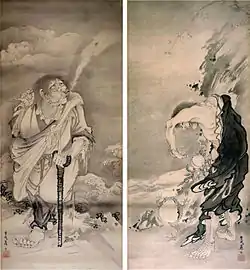Soga Shōhaku
Soga Shōhaku (曾我蕭白) (1730–1781) was a Japanese painter of the Edo period. Shōhaku distinguished himself from his contemporaries by preferring the brush style of the Muromachi period, an aesthetic that was already passé 150 years before his birth.[1]
Soga Shōhaku | |
|---|---|
%252C_Shoki_Ensnaring_a_Demon_in_a_Spider_Web%252C_18th_century%252C_Japan%252C_Edo_period%252C_Two-fold_screen%253B_ink_on_paper%252C_Kimbell_Art_Museum.jpg.webp) Shoki Ensnaring a Demon in a Spider Web by Soga Shōhaku. Ink on papered folding screen. Photograph by Kimbell Art Museum. | |
| Born | Miura Sakonjirō 1730 |
| Died | 30 January 1781[1] Kyōto |
| Nationality | Japanese |
| Occupation | Painter |
Shōhaku's birth name was Miura Sakonjirō. His family was wealthy, but all of his immediate family members died before he reached the age of 18.
Work and studies
As a young man, he was a student of Takada Keiho of the prominent Kanō School, which drew upon Chinese techniques and subject matters.[2] His disillusionment with the school led him to appreciate the works of Muromachi era painter Soga Jasoku. He began to use the earlier style of brushstroke, painting mostly monochromes, despite the fact it had become unfashionable.[1]
Gallery
 The Daoist Immortal: Li Tieguai and Liu Haichan (Museum of Fine Arts Boston)
The Daoist Immortal: Li Tieguai and Liu Haichan (Museum of Fine Arts Boston) Orchid pavilion gathering (National Gallery of Victoria)
Orchid pavilion gathering (National Gallery of Victoria) The Three Laughers of Tiger Ravine (Indianapolis Museum of Art)
The Three Laughers of Tiger Ravine (Indianapolis Museum of Art).jpg.webp) Beauty (Nara Prefectural Museum of Art)
Beauty (Nara Prefectural Museum of Art) Sessen Dōji-zu (Mie Prefectural Art Museum)
Sessen Dōji-zu (Mie Prefectural Art Museum)
References
- "Soga Shōhaku". Encyclopædia Britannica Online. Encyclopædia Britannica, Inc. Retrieved 25 June 2013.
- Aviman, Galit (2014). Zen Paintings in Edo Japan (1600-1868): Playfulness and Freedom in the Artwork of Hakuin Ekaku and Sengai Gibon. New York: Routledge. p. 161. ISBN 978-140947-04-27.
External links
 Media related to Soga Shohaku at Wikimedia Commons
Media related to Soga Shohaku at Wikimedia Commons- "River Landscape by Soga Shōhaku". Brooklyn Museum. 1998. Retrieved 20 June 2013.
- Bridge of dreams: the Mary Griggs Burke collection of Japanese art, a catalog from The Metropolitan Museum of Art Libraries (fully available online as PDF), which contains material on Soga Shōhaku (see index)
